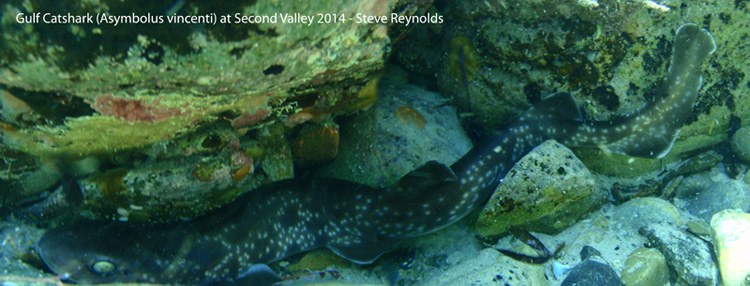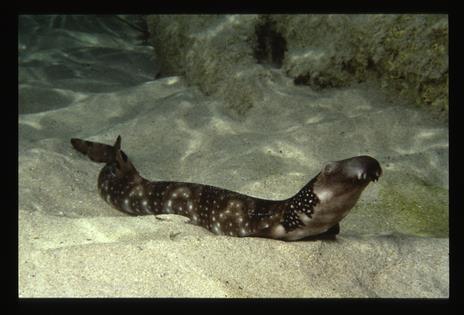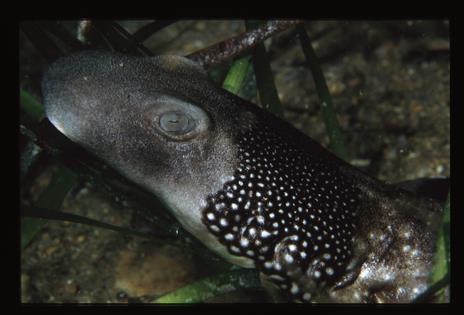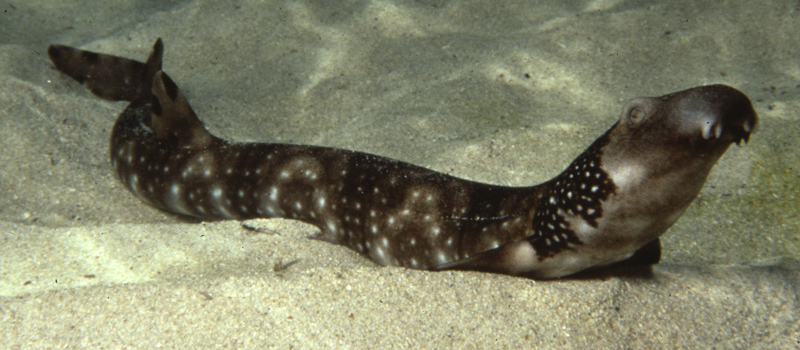Allan Horsfall found a small shark during our dive together at Second Valley on 6th September 2014. We had entered the water in the second bay to the left of the jetty. I was ahead of Allan as I proceeded to head out along the rocky headland there. When I looked back to check on Allan’s progress, he was calling me back to where he had stopped in the shallows. He pointed out a small shark resting at the base of a rock. I was sure that he (Allan) wanted me to photograph the shark with my camera. Although it was a little bit difficult in the swirly shallows, I managed to get a handful of shots of the shark.

MLSSA member Dan Monceaux was able to merge the two best shots (each showing only half of the animal) into a single complete image.
After our dive, Allan I discussed the shark sighting in detail. I suggested that it was some kind of catshark or possibly a blind shark.
I didn’t know much about blind sharks, only that I seemed to recall seeing images of them and thinking that they were somewhat similar to our sighting. Details about blind sharks were found back at home in “A Guide to Sharks & Rays” by Tricas, Deacon, Last, McCosker, Walker & Taylor. The scientific name for a Blind Shark is Brachaelurus waddi. Although the image featured in the book somewhat resembled our sighting, the range given for the species was northern and eastern Australia. “Guide to Sea Fishes of Australia” by Rudie Kuiter suggests that the species is only found on the mid-east coast of Australia.
It just so happened that another of my suggestions for the identification of the shark was featured on the preceding page facing the one for the Blind Shark. I had considered that our sighting may have been a Varied Catshark, Parascyllium variolatum. This species was being called the Necklace Carpetshark in “A Guide to Sharks & Rays”. The range for this species is given as Southern Australia. I recalled that fellow MLSSA member David Muirhead had photographed the species before. Two of his images are included in our Photo Index (Nos. 1210 and 1274). The first one (1210) was taken at Stokes Bay on Kangaroo Island. It featured as the small insert image for February in our 2002 calendar . The second image (1274) was taken at Rapid Bay in December 2003.

Varied Catshark, Parascyllium variolatum
(Slide No.1210 in our Photo Index)
Taken at Stokes Bay, Kangaroo Island by David Muirhead
“A Guide to Sharks & Rays” by Tricas, Deacon, Last, McCosker, Walker & Taylor refer to Parascyllium variolatum as the ‘Necklace or Collared Carpetshark’ due to the dark band, or collar, studded with small bright white spots that encircle the head like a necklace.

Head shot of a Varied Catshark
(Slide No.1274 in our Photo Index)
Taken at Rapid Bay by David Muirhead in December 2003
The book describes Parascyllium variolatum as having a long, slender and slightly flattened body, and a long tail. The body is said to be dark grey-brown and scattered with numerous white spots. There are large dark blotches on the edges of the fins. It has small spiracles, auxiliary respiratory openings behind the eyes. These take in water for breathing when the shark is either resting on the bottom or when the mouth is being used for feeding. The nostrils bear short barbels and grooves that connect to the mouth. A barbel is “A slender, fleshy protuberance on the lower jaw. It is equipped with sensory and chemical receptors and is used in the location of food”. The barbels of Parascyllium variolatum are said to probably be for “chemosensory purposes”.
The book also says that Parascyllium variolatum is a carpetshark, not a catshark. It says that they are related to nurse sharks and wobbegongs. They are often mistaken for catsharks which they superficially resemble. They are distinguished by their mouth which is located well in front of their eyes.
There are two genera of collared carpetsharks. These are Cirrhoscyllium and Parascyllium (Family Parascyllidae). Cirrhoscyllium have barbels on the throat whereas Parascyllium do not. Parascyllium variolatum is said to be “common on shallow rocky reefs along the southern temperate coast of Australia. It feeds and is active at night, and is often encountered by divers after dark. During the day it is difficult to spot because it rests either in caves or on the bottom, where it is camouflaged among the algae.”
Parascyllium variolatum reach a length of about 1m. They are considered to be harmless. “A Guide to Sharks & Rays” shows one of these sharks being attacked by an 11-armed starfish, Coscinasterias muricata. These starfish will apparently attack and eat most animals. Parascyllium variolatum is oviparous, laying egg cases with curled tendrils that anchor to the substrate.
Little is said to be known about its diet. It is thought to probably feed on invertebrates and small fishes. According to “Sharks and Rays of Gulf St Vincent” by J.L. Baker, K.R. Rodda & S.A. Shepherd, “Two species of collared catsharks, the rusty catshark or carpetshark, Parascyllium ferrugineum, and the varied catshark, P. variolatum, both endemic to Australia, commonly occur in coastal southern waters and in Gulf of St. Vincent.” According to “Towards a System of Ecologically Representative Marine Protected Areas in South Australian Marine Bioregions – Technical Report” by J.L Baker (Dept Environment and Heritage, Adelaide (2004), “These sharks are found in caves and under ledges on reefs, and also in beds of macroalgae or seagrass. They are nocturnally active, feeding on bottom-dwelling crustaceans and molluscs.”
(Both of the above references quote “Compagno, L. (2001) FAO Species Catalogue Volume 4. “Sharks of the World” Part 1: Hexanchiformes to Lamniformes. Part 2: Carcharhiniformes. FAO Fisheries Synopsis 125 / 4 (1), 1-655. (FAO, Rome)”.)
“Guide to Sea Fishes of Australia” by Rudie Kuiter says that there are two genera of collared catsharks, with only one genera (Parascyllidae) found in Australian waters. The book says that they are benthic sharks (bottom dwellers) resembling true catsharks. It seems that collared catsharks are different to true catsharks in that collared catsharks have distinct nasal barbels, a groove joining nostrils to the mouth, and a mouth that does not reach below their eyes.
“Guide to Sea Fishes of Australia” goes on to say that collared catsharks are “Slender fishes with (a) small head” and have “Ventral, dorsal and anal fins alternate in position along (the) body”. Only Parascyllium variolatum is described in detail. Parascyllium ferrugineum, the Rusty Catshark, is said to occur mainly offshore and rarely seen, although it sometimes comes inshore at night. It is paler in colour than Parascyllium variolatum, has “dusky saddles and small black spots over most of the body”.
Parascyllium variolatum is said to occur down to a depth of 180 metres but “Commonly enters shallow coastal bays in mixed rock and seagrass habitats”.
The egg case of the Rusty Catshark, Parascyllium ferrugineum, is shown in “The Marine & Freshwater Fishes of South Australia” by Scott, Glover & Southcott. The book also describes the species in brief detail. In November 1985, I captured what I identified at the time as being a ‘spotted cat shark’ at Second Valley, SA. It may, or may not, have been a Spotted Catshark, Halaelurus analis, or a Dark-spotted Catshark, Asymbolus analis. According to the web page found at http://species-identification.org/species.php?species_group=sharks&menuentry=soorten&id=322&tab=synoniemen , both are the same species (Asymbolus analis). That species, however, is only found in southern NSW according to “Guide to Sea Fishes of Australia”.
Perhaps ‘my’ spotted cat shark was actually a Gulf Catshark, Asymbolus vincenti (formerly Halaelurus vincenti). Both the Dark-spotted Catshark, Asymbolus analis, and the Gulf Catshark, Asymbolus vincenti, are described in both “The Marine & Freshwater Fishes of South Australia” and “Guide to Sea Fishes of Australia”.
My captured ‘spotted cat shark’ from Second Valley in 1985 was placed in an aquarium that day. The placing of the (female) shark in an aquarium may have caused her to lay two eggs which were found in the aquarium the next day. I am unable to report any further details other than that my best recollection of the event is that the aquarium belonged to a neighbour of mine.


Carey Harmer says that catsharks are “Very commonly seen between September and January (and) if you lay still enough they’re very inquisitive and will swim up to you. I’ve had one hide between me and my housing while filming Leafy’s.”
“Mostly (seen) Fleurieu peninsula, but also upper Yorkes as well – Wallaroo, Pt Hughes, Ardrossan, etc..” Thanks Carey.
It turns out that my old neighbour with an aquarium says that the only shark
egg in his aquarium was a Port jackson shark egg that I gave to him once.
I have no memory of what happened to the catshark eggs in an aquarium now.
Steve,a silly aside-in your tail shot,there’s a rock in front of the shark that resembles a very large cone shell,but is only a rock!Pity,cld have been a new Conus sp. discovery!!
David Muirhead
Hi again Steve:I’ve just browsed my hard-cover ‘Fishes of Australia’s Southern Coast'(Gomon Bray Kuiter 2008),and I’m fairly sure the small catshark you photographed on this recent dive @ Second Valley is a Gulf Catshark Asymbolus vincenti.
It is depicted and described on page 59,but the stated distribution,’Bottom dweller at 130-220m’ is incorrect,and it is definitely known to also occur in shallow inshore rocky reefs in SA,including GSV.
I state this having had personal communication with an expert SA marine ecologist,and that email conversation was the result of my own failed attempt at identifying an equally small ?catshark/?carpetshark I photographed in Spring last year @ Carrickalinga during a shore dive.
Because the above excellent and generally very accurate book effectively excluded A.vincenti as an option for ID of the shark in my images,I’d opted for Rusty Carpetshark P.ferrugineum.
After perusing my Carrickalinga images,taken at approx.5-7m depth, the expert stated with high confidence level that it was a Gulf Catshark and that sightings by SA divers in equally shallow depths are not uncommon.
I can readily see why you appear to have gone with P.variolatum,however your shark lacks the one highly distinctive feature of that carpetshark,ie the striking and consistently present ‘unique broad,blackish,white-spotted collar around gills'(I’ve again quoted from the above book,page 46).
Regards,
Dave Muirhead
Wow! Thanks, David. That is an amazing revelation. So it seems to be a Gulf Catshark, Asymbolus vincenti. I tend to agree after reviewing my fish reference books. As for the apparent cone shell, a missed opportunity gone begging.
I had suggested in my article that the spotted cat shark from Second Valley in 1985 was a Gulf Catshark, Asymbolus vincenti. It now seems that my latest sighting at Second Valley 29 years later is that same species.
[…] Catsharks and Blind Sharks […]